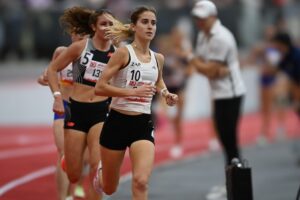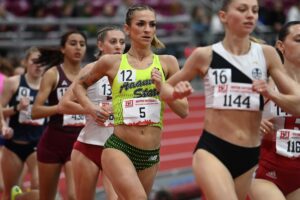
In December 2021, USATF announced that the qualifying standard for the 2024 U.S. Olympic Marathon Trials would be 2:37:00, an eight-minute drop from the 2020 standard. In 2020, 511 women qualified for the Trials. It was clear that the 2024 Trials would be significantly smaller. The question was how much smaller.
The qualifying window has been open for nearly 15 months now, and to date, 113 women have hit the marathon or half marathon standard (1:12:00). With each passing race, it’s apparent the field will be much smaller than 2020’s field. The standards are tough. But whether or not they earn a spot on the starting line on February 3, 2024 in Orlando, hundreds of women continue to plug away at the goal—and they’re finding community in the effort.
One of those women is Lauren Ross, of Portland, Oregon. Ross, a 2:43 marathoner, missed qualifying for the 2020 Trials by 34 seconds, and she’s giving it another shot this time around. “I think a huge draw of the OTQ and the sport of running itself, for me, is the social aspect of it,” she told Fast Women.
I reached out to Ross and Starla Garcia of Houston shortly after they hosted a shakeout run for Trials hopefuls, in conjunction with January’s Houston Marathon. They’ve approached Trials qualifying as a team effort. They want to make it to Orlando, and they want to bring as many other women as possible with them.
Garcia, a 2020 Trials qualifier, felt the camaraderie in the last cycle and wanted to keep the momentum going this time around. “When we got to the Trials, it was like we had these built-in friendships already and you hadn’t even met them yet,” Garcia said. “But you felt so connected to what they did and understood everything that they went through… I think when the new standard came out, everyone was like, ‘Who’s game?’”
Garcia and Ross say this is a pursuit with many different leaders, and those interested in working together tend to find one another using hashtags, via Strava, and there’s even a small Facebook group for those going after the OTQ. They use those tools to help coordinate where they’ll race next and occasionally trade tips.
Not only is the community aspect fun, Ross finds that it helps her run faster. “I really thrive on the energy of the group,” she said. “Having a lot of people together and being able to turn off your brain and trust that the group is running what you need to run, that is huge. It’s really, really difficult to be super mentally sharp for two and a half hours.”
Some men are helping. One of them, Rick Powell, has centered his recent racing schedule around pacing women aiming to hit the standard. He even created an Instagram account to spread the word. He’s not quite fast enough to hit an OTQ time of his own, nor is he a U.S. citizen. But he has carved out a niche helping others. “These women have done thousands of miles to get to that point,” he said. “To help them achieve a once-in-a-lifetime goal is absolutely worth it. I’ll do this until my legs fall off.”
Forty-three of the 112 qualifiers achieved their OTQ time at the 2022 California International Marathon (CIM) in Sacramento, which has a fast course and relatively reliable weather. (Some of the events that should have produced a bunch of qualifiers have been a flop weather-wise.) CIM is on December 3 this year, only two days before the qualifying window closes, and many runners don’t want to leave it until that late.
That has put a lot of weight on Grandma’s Marathon, held in Duluth, Minnesota, in June, which has a fast course. Summer racing can be hot, but because the course and town are along Lake Superior, the weather tends to be significantly cooler. Last year the conditions were excellent.
Sarah Culver, the race’s elite athlete director, said the elite and sub-elite fields filled faster than ever this year. She told athletes to contact her after January 1, and she heard from about 400 of them within a week. When I talked to her a couple weeks later, she already had 100 athletes in the women’s elite field and 100 more in the semi-elite field. Others were still welcome to enter the race, but they wouldn’t get elite status. (The race has since sold out.) Only the top 40 women get bottle support (fluids of their choosing, available at fixed intervals) on the course.
Getting a preferred spot in the fastest races can be tough, and that’s part of the reason Heather Knight Pech and James McKirdy have created the McKirdy Micro – On the Cusp Marathon, which will take place October 14, 2023, at New York’s Rockland Lake State Park. It will compete with more established fall marathons for runners, but it’s a flat course, the race starts early in the morning, and every accepted runner will get personal fluids. (The event doesn’t have a website yet, but you can reach out to james@mckirdytrained.com for more information.)
Regardless of how many women run sub-2:37, the goal is helping many women run faster times than they previously thought were possible. Both Garcia and Ross understand that this chase is as much about the journey as anything else. Garcia had a tough day in Houston this year—many people did, due to the heat and humidity. “I really hope a lot of people at the race saw people like me going for it, not doing it, and being okay with it,” she said. “I saw a lot of young Latina girls handing out water and cheering. I hope they saw that at least I put myself out there.”





